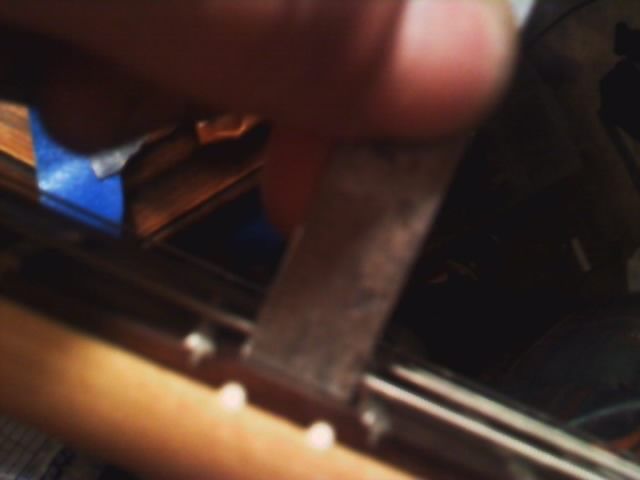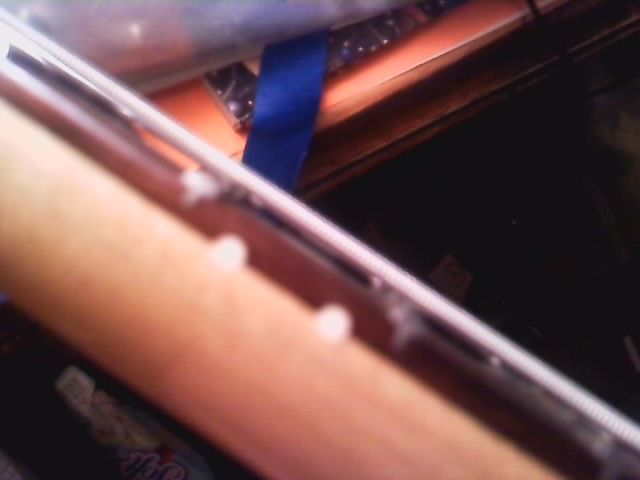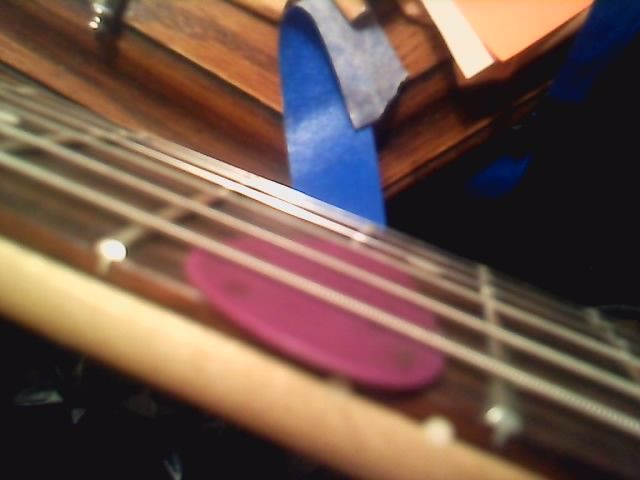truss rod adjustment, the right way, and the wronger way.
Posted: Sun Jul 28, 2013 7:13 am
yeah, i said wronger on purpose.
so, I shouldn't have to make this thread, becuz we are shortscale, we don't give a fuck about amber tips and dinky shit, we want to RAWK! and RAWK we shall.
but first! How many people honestly and truly know how to adjust the truss rod in the guitar neck? becuz keeping it perfectly straight or over correcting it still isn't as bad as not doing anything at all.
There has been 3 times that I can recall looking at a members guitar and realizing that they have a certain guage of string or a tuning that required the neck to be adjusted, just to find out that the truss rod was loose and they had never bothered, i suppose they like driving trucks under the strings. J-Mascis was quoted to saying "Your action and be too low, but it can't really be too high" and Dick Dale Prefers high action for optimum string oscillation. But, even then the neck still needs to have a truss rod to counter act the string tension. there is a trick to it.
-For the average everyday player that likes low or medium string height(generally 3-5 mms depending) you need to be able to look down the fretboard,(from the heel to the headstock) and see it be completely straight until it reaches the 3rd fret, then you should see some slight relief. that is perfect for about 90% of playing styles. and the relief should be able to be measure by fretting from the 3rd to the 12th and struming inbetween with no sound being able to... sound. what i mean is that the string should not be able to vibrate between these two frets(when fretted) but if you fret the twelth and strum behind that you should hear a small amount of vibration, not alot, but some. if you fret from the 5th and strum behind that you should also be able to hear a small amount and you should be able to measure in both instances to see the exact amount of relief that you have.
-For the player who likes higher action you still want some tension on your rod(hahahaha) but not as much, instead the relief will be about the 5th-7th fret(depends on scale and truss rod style, compound vs two way, heel vs neck) the relief will be gradual so it will be pretty straight from the heel up to the 7th, then the relief will start, and by the 5th fret you see a nice curve, not too sharp, but enough to add about 1/32 of an inch higher action at the first fret.(don't actually measure all that) anywho. if you do nothing, then you might as well just burn the money you used to buy the guitar, it will be more enjoyable and punk as fuck.
-Even tho all the frets must be the same height(this includes the nut slots) you DO NOT want the neck to be perfectly straight, if it is perfectly straight while strung up and the truss rod counter acting the string tension then you will get weird fret buzz from the first to the third fret(generally, could be more if you over adjust)
this is bad, do not do it.
Rodvonbon has a competition mustang, i believe it to be a 72. anywho. when he got it, someone had either left the truss rod adjusted too much with strings on it, or left it adjusted with string off for many years. this caused a constant arch in the neck, his remedy was to put heavey ass fucking strings on it and tune it really high with the truss rod completely loose, he left it like that for LONG TIME to try and get the neck back to a somewhat useable state. and as far as i know, it worked just fine.
-the opposite of this is when you don't do anything at all to the truss rod and leave it strung up with heavy strings.
this is rather common, imagine this. you go to the music store, you play a guitar, its great! you take it home, and put new strings on it, so you rip off those shitty 8-36 gauge strings and put on your 12-58 gauge strings. all the sudden it doesn't feel like it did, the action is higher and you don't know why, it was awesome at the store right?
well you don't think much of it and before you know it, you have stopped playing it cuz "it doesn't feel right" and three years later you decide to sell it or whatever.
well, since you DID NOT ajust the truss rod to the new gauge of string. the neck has been in a constant bow for three years and getting that bow out can almost be impossible. wood will warp. wood will RARELY EVER warp back to its original state. especially kiln dried stuff thats been treated and retains a higher than normal moisture content(normal moisture is like 7-15% or something stupid like that)
our ole pal aen had a mustang bass. at the store it was FUCKING AWESOME. then he took it home, put on his fav gauge of string and tuned it to his classic style and before he knew it, the action sucked ass. luckily i saw it, gave it the ole 1,2 1,2 action and it was all better, but if he would have left it that way and didn't pay too much mind to it, then it pretty much would have been trashed.
im not pointing to people and saying he or she is dumb, im just giving examples.
PLEASE shortscale, for the love of your guitar, learn to adjust the truss rod properly with the right amount of relief so that it will keep on bringing those sweet sweet RAWK tonez that we all crave.
----some tips----
if you have a painted neck with binding(most acoustics/gibsons) put the butt of the guitar up to your chest and look down the fretboard from the heel to the headstock. use the string as an indication of a mechanically straight line, and folle the binding. you will be able to see the relief and the way the neck curves. I say try it with binding and a painted neck cuz its easier to see as opposed to a one piece maple tele neck with exposed fret ends. it may take you a few guitars and a few weeks or so to really start to know what you are looking at and what to look for. and PLEASE if you have a tech, just ask him some questions or pointers, if he/she isn't a cock nibbler then they should be willing to show you, if not, its time to get a new tech.
thank you all for reading my long winded rant about the truss rod, its not hard. but it is, if you make it so(hahahahaha)
so, I shouldn't have to make this thread, becuz we are shortscale, we don't give a fuck about amber tips and dinky shit, we want to RAWK! and RAWK we shall.
but first! How many people honestly and truly know how to adjust the truss rod in the guitar neck? becuz keeping it perfectly straight or over correcting it still isn't as bad as not doing anything at all.
There has been 3 times that I can recall looking at a members guitar and realizing that they have a certain guage of string or a tuning that required the neck to be adjusted, just to find out that the truss rod was loose and they had never bothered, i suppose they like driving trucks under the strings. J-Mascis was quoted to saying "Your action and be too low, but it can't really be too high" and Dick Dale Prefers high action for optimum string oscillation. But, even then the neck still needs to have a truss rod to counter act the string tension. there is a trick to it.
-For the average everyday player that likes low or medium string height(generally 3-5 mms depending) you need to be able to look down the fretboard,(from the heel to the headstock) and see it be completely straight until it reaches the 3rd fret, then you should see some slight relief. that is perfect for about 90% of playing styles. and the relief should be able to be measure by fretting from the 3rd to the 12th and struming inbetween with no sound being able to... sound. what i mean is that the string should not be able to vibrate between these two frets(when fretted) but if you fret the twelth and strum behind that you should hear a small amount of vibration, not alot, but some. if you fret from the 5th and strum behind that you should also be able to hear a small amount and you should be able to measure in both instances to see the exact amount of relief that you have.
-For the player who likes higher action you still want some tension on your rod(hahahaha) but not as much, instead the relief will be about the 5th-7th fret(depends on scale and truss rod style, compound vs two way, heel vs neck) the relief will be gradual so it will be pretty straight from the heel up to the 7th, then the relief will start, and by the 5th fret you see a nice curve, not too sharp, but enough to add about 1/32 of an inch higher action at the first fret.(don't actually measure all that) anywho. if you do nothing, then you might as well just burn the money you used to buy the guitar, it will be more enjoyable and punk as fuck.
-Even tho all the frets must be the same height(this includes the nut slots) you DO NOT want the neck to be perfectly straight, if it is perfectly straight while strung up and the truss rod counter acting the string tension then you will get weird fret buzz from the first to the third fret(generally, could be more if you over adjust)
this is bad, do not do it.
Rodvonbon has a competition mustang, i believe it to be a 72. anywho. when he got it, someone had either left the truss rod adjusted too much with strings on it, or left it adjusted with string off for many years. this caused a constant arch in the neck, his remedy was to put heavey ass fucking strings on it and tune it really high with the truss rod completely loose, he left it like that for LONG TIME to try and get the neck back to a somewhat useable state. and as far as i know, it worked just fine.
-the opposite of this is when you don't do anything at all to the truss rod and leave it strung up with heavy strings.
this is rather common, imagine this. you go to the music store, you play a guitar, its great! you take it home, and put new strings on it, so you rip off those shitty 8-36 gauge strings and put on your 12-58 gauge strings. all the sudden it doesn't feel like it did, the action is higher and you don't know why, it was awesome at the store right?
well you don't think much of it and before you know it, you have stopped playing it cuz "it doesn't feel right" and three years later you decide to sell it or whatever.
well, since you DID NOT ajust the truss rod to the new gauge of string. the neck has been in a constant bow for three years and getting that bow out can almost be impossible. wood will warp. wood will RARELY EVER warp back to its original state. especially kiln dried stuff thats been treated and retains a higher than normal moisture content(normal moisture is like 7-15% or something stupid like that)
our ole pal aen had a mustang bass. at the store it was FUCKING AWESOME. then he took it home, put on his fav gauge of string and tuned it to his classic style and before he knew it, the action sucked ass. luckily i saw it, gave it the ole 1,2 1,2 action and it was all better, but if he would have left it that way and didn't pay too much mind to it, then it pretty much would have been trashed.
im not pointing to people and saying he or she is dumb, im just giving examples.
PLEASE shortscale, for the love of your guitar, learn to adjust the truss rod properly with the right amount of relief so that it will keep on bringing those sweet sweet RAWK tonez that we all crave.
----some tips----
if you have a painted neck with binding(most acoustics/gibsons) put the butt of the guitar up to your chest and look down the fretboard from the heel to the headstock. use the string as an indication of a mechanically straight line, and folle the binding. you will be able to see the relief and the way the neck curves. I say try it with binding and a painted neck cuz its easier to see as opposed to a one piece maple tele neck with exposed fret ends. it may take you a few guitars and a few weeks or so to really start to know what you are looking at and what to look for. and PLEASE if you have a tech, just ask him some questions or pointers, if he/she isn't a cock nibbler then they should be willing to show you, if not, its time to get a new tech.
thank you all for reading my long winded rant about the truss rod, its not hard. but it is, if you make it so(hahahahaha)



